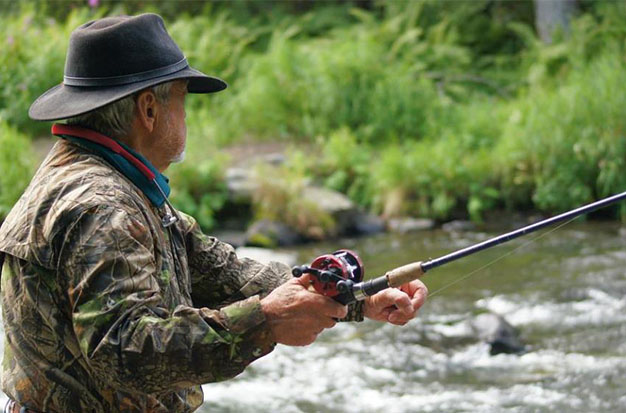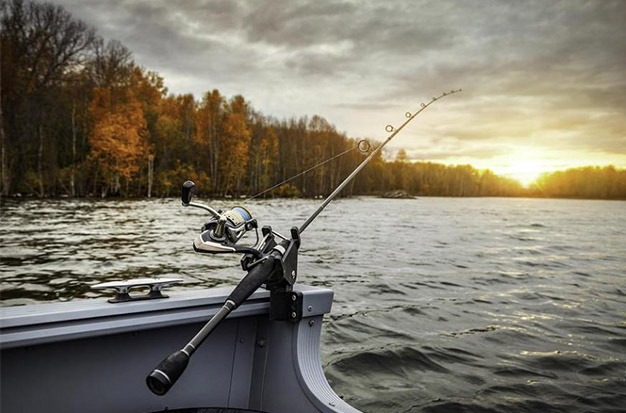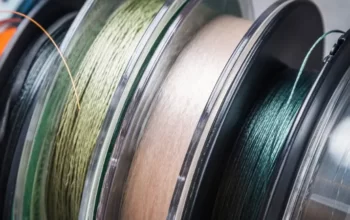One of the fundamental fishing techniques you must master is casting a rod. It is a talent that must be continuously honed. Spending some time practicing can improve your skills as an angler, whether you’re a novice or a seasoned pro.
Although the fundamentals can be as straightforward as timing the release of your lure with the swing of your fishing rod, each type of rod has distinct design features and casting mechanics that can alter how you cast.
We’ve put together a quick guide on the various casting techniques based on the type of rod you have to help you get the hang of casting and get you started in the right direction.
Table of Contents
How To Cast A Fishing Rod?
Casting a fishing rod involves a variety of methods or techniques. However, you should stick to the fundamental procedures if you want to get off to a good start and cast your fishing rod correctly.
The simplest cast to learn is the overhead cast, which is frequently regarded as the fundamental fly-fishing cast technique.
Even when you are an experienced angler, you will still use this method, particularly when casting in areas that call for long distances.
Casting Your Fishing Rod The Right Way
In essence, there are two main steps to correctly casting your fishing rod.
Swing the rod backwards over your head
Quickly accelerate the rod forward
There are more to those two steps than meets the eye, despite the fact that there are only two main steps and they may appear straightforward. We’ll break them down thoroughly so you can cast your rod correctly in no time.
Before Casting
- Always use your dominant hand to hold the rod. Normal practice dictates that you should place the reel foot between your middle and ring fingers, but if another position makes you more comfortable, go with it.
- You must reel in the lure after baiting your hook until you have 12 to 24 inches of free line from the rod tip.
- Whether you are using spinning equipment or a bait caster determines what comes next. You should keep the bail open and put your finger on the line when using spinning gear. Keep your thumb on the line and keep the spool free when using a bait caster.
Step #1: Swing the Rod Backwards Over Your Head
To make the rod point behind you, swing it back over your head. The angle should be measured in relation to 10 o’clock.
Step #2: Quickly Bring the Rod Forward to Cast
- Quickly begin bringing the rod forward as soon as you finish your backswing. This assists in weighing down the rod with the weight of the lure and causes it to bend under the force.
- Release the line or detach your thumb from the spool when the rod is at an angle of 12:00.
- Finish your cast by swinging your rod all the way to 2:00.
Almost any lure you can think of can be cast overhead. It’s ideal when you can cast far out past the fish. This is due to the lure’s big splash when it hits the water, which can startle fish.
Ensuring Proper Timing
Poor timing is a common cause of casting problems. The line should ideally be kept tight at all times.
When casting, if the line shoots straight up into the air, you prematurely released your index finger.
You released the lure too late if, after casting, it starts to fall toward your feet.
Swinging the fishing rod forward as your casting arm extends and pointing your index finger straight in the direction of your intended target is a good way to make sure the release is timed properly. Usually, this causes the line to release precisely when it should.
You should grip the rod as firmly as you would a handshake, which should be very firm. By doing this, you can be sure that you have complete control over the rod during the cast.
How Do I Cast A Spinning Rod?
Spinning rods are by far the most common rod types among beginners. So, here are the basic steps that will explain how to cast a spinning rod.
STEP #1: Open the bail and hold the rod so that your index finger is on the line.
STEP #2: Make the necessary adjustments to the line so that your bait is suspended about 7 inches above the tip. Casting is negatively impacted by using too much or too little line.
STEP #3: Aim for the desired area while holding the rod.
STEP #4: Over your head, pull the rod in the opposite direction.
STEP #5: The crucial step is to swing it forward and let go of the line while pointing it in the right direction for the intended location.
STEP #6: Close the bail.
How Should A Baitcasting Rod Be Cast?
Baitcasting rods are a bit more complicated. Beginners often have problems with backlashes. Make sure that you learn this technique by casting downwind and avoid casting upwind before you master it.
STEP #1: You should first check your spool tension. Hold your rod out in front of you horizontally and depress the thumb bar. Everything is fine if the lure is falling toward the ground.
STEP #2: In the same way you would with a spinning rod, pull the rod backward over your shoulder and behind your head.
STEP #3: In order to stop the spool from turning, depress the thumb bar and maintain pressure on it with your thumb.
STEP #4: Swing the rod forward and point it in the direction you want.
STEP #5: By moving your thumb, you can release the strain you were applying to the spool.
STEP #6: Use the reel handle to reel in two circles to engage anti-reverse once you have reached the desired location.

How Do I Cast A Surf And Beach Rod?
Surf fishing requires distant casts and rods are usually quite long. For a beginner, this might be a little difficult, but it isn’t all that different from a technique that has been described before.
STEP #1: Both of your hands should be firmly on the rod. Two places where you can hold the line are on the bottom, and one is close to the reel.
STEP #2: Swing the rod forward and back over your shoulder. This pulling and pushing motion is crucial. The rod should be pulled from underneath and pushed from the top. With a form grip, you have control over this. What I’m talking about will be felt by you.
STEP #3: Release the lure in the direction of your choice.
These three steps may seem easy and similar to a spinning rod, but you need a lot of fluidity but also firmness in your motion. You can cast farther, but not by using force, thanks to larger equipment and heavier lures. Here, technique is very important.
How Do I Cast A Fly Fishing Rod?
Fly fishing is an art and knowing how to cast a fly fishing rod makes you an artist. So before we get to the steps themselves, here are some tips:
STEP #1: Use heavier tapered lines.
STEP #2: Avoid using excessive motion. Motions backward and forward must be quick, short, and firm.
STEP #3: Avoid an abrupt stop that will cause the rod to twitch by decelerating quickly but smoothly.
And now for the procedures. Remember that the reel’s only purpose is to hold the line; there is no lure weight to pull the line. It’s all about technique.
STEP #1: Draw out a fly line about three-rod lengths.
STEP #2: As you stand, face the direction you want to go.
STEP #3: As soon as the rod’s tip is up and behind you, quickly move it backward.
STEP #4: Make a brief stop to allow the line to unroll before moving the rod forward quickly but with control.
STEP #5: Casting should be stopped before the rod tip points in the direction intended. When the tip has just passed the vertical point, stop it.
STEP #6: The line will be propelled in the desired direction by energy transfer, and the rod’s point will be lowered as it unrolls.
Other Helpful And Beneficial Casting Techniques
There are two additional essential advantageous casting methods: the sidearm cast and the drop cast. Details about them are provided in the table below.
Sidearm Cast
- Produces less splash (preferred)
- Requires accuracy and strength (similar to swinging a baseball bat)
- Most effective in windy weather
Drop Cast
- More splashing involved
- Casting straight down into the water
- Great for catching fish deep in the water (and more beginner-friendly)
Additional Equipment To Help You Cast
You can cast your rod more easily by using one of the many accessories and pieces of gear available. When learning to cast your fishing rod properly, these accessories can help you hone your techniques. They are not just for decoration.
A few of the items on the list, like fishing line, are required, though you can purchase an improved fishing line to aid in your casting education. Simply using other items can help you catch more fish or recognize when fish are engaging with your line.
- Fishing Line
- Fishing Hooks
- Floaters/Bobbers
- Sinkers
- Swivel
- Line Cutter
How Can You Master Casting Your Fishing Rod?
You might wonder if you can become an expert at casting a fishing rod after learning the fundamentals. You’ve learned the fundamentals using this guide, so now it’s up to you to apply what you’ve learned.
By using the right methods, putting them into practice, and researching other anglers’ methods, you can master the art of casting your fishing rod. Additionally, you can pick up other strategies and techniques from experienced fishermen, like false casting. In any case, if you are committed to following these instructions, you can quickly advance your new skill.
Main Ways to Become an Expert at Casting Your Fishing Rod
- Use Proven Techniques
- Practice, practice, practice!
- Study Other Anglers
- Use False Casting
- Using Proven Techniques
Focus on one casting technique at a time. Start with the Overhead Cast, and once you know how to use it, use it frequently.
Don’t switch to another casting technique until you are confident using the overhead cast. Then you can attempt even more challenging casting techniques.
Conclusion
The correct way to cast a fishing rod can be learned, in conclusion. Start with the overhead cast, then try the sidearm cast and drop cast once you’re comfortable with that technique.
You’ll feel more assured that you’ve developed the skills of an experienced angler if you can execute a variety of casts due to the changing weather and water conditions.
Naturally, getting the ideal cast requires perseverance, time, and work. Most importantly, though, is that it takes practice. You will only be able to achieve the ideal cast over time by repeatedly using your new skill.




